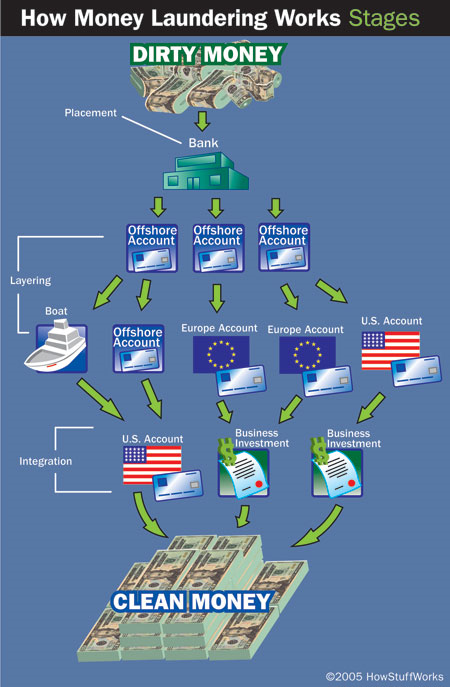Money Launderering Basics |
The most common types of criminals who need to launder money are drug traffickers, embezzlers, corrupt politicians and public officials, mobsters, terrorists and con artists. Drug traffickers are in serious need of good laundering systems because they deal almost exclusively in cash, which causes all sorts of logistics problems. Not only does cash draw the attention of law-enforcement officials, but it's also really heavy. Cocaine that's worth $1 million on the street weighs about 44 pounds (20 kg), while a stash of U.S. dollars worth $1 million weighs about 256 pounds (116 kg). The basic money laundering process has three steps:
Money laundering is a crucial step in the success of drug trafficking and terrorist activities, not to mention white collar crime, and there are countless organizations trying to get a handle on the problem. In the United States, the Department of Justice, the State Department, the Federal Bureau of Investigation, the Internal Revenue Service and the Drug Enforcement Agency all have divisions investigating money laundering and the underlying financial structures that make it work. State and local police also investigate cases that fall under their jurisdiction. Because global financial systems play a major role in most high-level laundering schemes, the international community is fighting money laundering through various means, including the Financial Action Task Force on Money Laundering (FATF), which as of 2005 has 33 member states and organizations. The United Nations, the World Bank and the International Monetary Fund also have anti-money-laundering divisions.
Most money-laundering schemes involve some combination of these methods, although the Black Market Peso Exchange is pretty much a one-stop-shopping system once someone smuggles the cash to the peso broker. The variety of tools available to launderers makes this a difficult crime to stop, but authorities do catch the bad guys every now and then. In the next section, we'll take a look at two busted money-laundering operations. There are between 700,000 and one million electronic funds transfers undertaken world-wide every day. The vast majority of these are legitimate business to business, business to person, person to person, government to business or government to person (and all visa versa) transactions. But mixed into this plethora of legitimate activity are the funds derived from the proceeds of crime. These electronic transfers are part of the international washing machine that takes in dirty money (the proceeds of crime) in one place and spins out apparently genuine monetary transactions for value at another location. Do the launderers have the upper hand? Undoubtedly! The problem for the money launders (a “crim”[criminal] by any other name) is that so successful have they been at their “craft” that international terrorist organisations have started to use the techniques and channels used to launder proceeds of crime, drawing the unwanted attention of international law enforcement. Cheating on your taxes through black market trading it appears is one thing; using that same cheat system to kill, maim and injure hundreds of thousands around the world is clearly another. Governments around the world have united to stamp out the processes of organised crime that permit and facilitate money laundering through the use of complex software applications, physical restrictions on transportation of cash and reporting of suspicious transactions by everyone from banks to trade professionals. In the experience of members of the Financial Intelligence Group, money laundering in New Zealand has revolved around two distinct areas; proceeds of street crime (usually drug money) and white collar crime (usually fraud but also tax evasion). While the process of laundering is simple in theory there are critical points that are vulnerable to detection and investigation. Through careful analysis of transactions, the persons involved and the activities in which they have engaged our Financial Investigators trace proceeds of crime to detect the perpetrators of the schemes, the methods they use and to trace the proceeds of that crime with a view, where possible, to recovery. |




